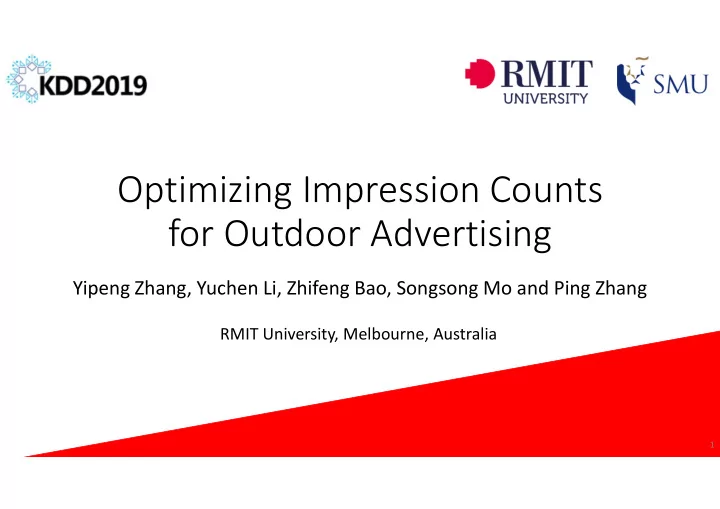

Optimizing Impression Counts for Outdoor Advertising Yipeng Zhang, Yuchen Li, Zhifeng Bao, Songsong Mo and Ping Zhang RMIT University, Melbourne, Australia 1
$30 Billion 80% 2
I Impression I I mpression mpression mpression C C Counts for C ounts for ounts for ounts for Outdoor O utdoor O O utdoor utdoor A A A Advertising dvertising dvertising dvertising Trajectory Billboards Budget 3
I I Impression I mpression mpression mpression C C C Counts for ounts for ounts for ounts for O Outdoor utdoor O O utdoor utdoor Advertising A A A dvertising dvertising dvertising Input: (1) Billboard database U ; (2) Trajectory database T ; (3) Budget Trajectory constraint B ; (4) Influence Measurement I(S) Billboards Output: Subset S ⊆ ⊆ ⊆ U that maximizes the overall influence of S such that ⊆ Budget the total cost of S does not exceed B. argmax ���� ���� � �� 4
1. How a billboard impresses an audience? � 5
2. Influence Measurement argmax �(�) ���� � �� ���� = � ���, � � � ( Ping et al., SIGKDD 2018 [1]) � � ∈� Is It enough for impressing a person only one time? Is It enough for impressing a person only one time? Is It enough for impressing a person only one time? Is It enough for impressing a person only one time? One-time impression is not enough (Gershon et al., 1985[2]; William et al., 2003 [3]) 6
2. Influence Measurement Influence 1 st Time Impression Times I see it! 7
2. Influence Measurement Influence 2 nd Time 1 st Time Impression Times It is familiar! 8
2. Influence Measurement 3 rd Time Influence 2 nd Time 1 st Time Impression Times I remember it! 9
Influence Impression Times 10
The logistic function (Advertising market and Customer behavior [4-7]) The effectiveness of advertisement repetition varies from one person to another. Influence Impression Times 11
The logistic function (Advertising market and Customer behavior [4-7]) The effectiveness of advertisement repetition varies from one person to another. Influence Impression Times 12
The logistic function (Advertising market and Customer behavior [4-7]) The effectiveness of advertisement repetition varies from one person to another. Influence Impression Times 13
Influence Measurement Influence �(�) = � �(�, � � ) Impression Times � � ∈� 14
1. Influence Measurement is not submodular - No approximation ratio for a greedy-based algorithm Upper-bound Estimation (submodular) 2. NP-hard to approximate within any constant factor Branch-and-Bound Framework Challenges 15
Upper-bound Estimation Tangent Point Upper Bound Influence Lower Bound Impression Times 16
Upper-bound Estimation Upper Bound Upper Influence Bound Influence Lower Lower Bound Bound Strategy 1 Impression Times 17
Upper-bound Estimation Influence Influence Strategy 1 Impression Times 18
Upper-bound Estimation Influence Influence Strategy 2 Strategy 1 Impression Times 19
Upper-bound Estimation Influence Influence Strategy 2 Strategy 1 Impression Times 20
Upper-bound Estimation Strategy 1 21
Branch-and-Bound Framework Branch 22
Optimization Approximation Effectiveness Efficiency Ratio 1 2 (1 − 1 BBS: Branch−and−Bound �) 1X 1X Framework PBBS: Branch-and-Bound " 2 (1 − 1 50 X � − #) Framework with Progressive 0.92X Bound-Estimation 23
Experiment - Statistics of datasets 2 1 1 TLC; 2 Lamar 24
Experiment - Algorithms • Greedy: Maximum ratio of marginal influence gain to cost • Top-k: Maximum number of trajectories • BBS: Branch-and-bound framework • PBBS: Branch-and-bound framework with progressive Bound Estimation • LazyProbe: The best-performing method in [1] Ping et al., SIGKDD 2018 [1] 25
Varying the budget $ Figure 1: Influence in NYC Figure 2: Influence in LA 26
Varying the number of trajectories |&| Figure 4: Influence in LA Figure 3: Influence in NYC 27
Scalability test in NYC 28
Comparison with LazyProbe 29
Conclusion • Real Problem • Meet more than one billboard in each travel (Impression Count) • Non-uniform cost of billboards • Budget • Real Solution • While having the approximation guarantee • Real-world Trajectory Dataset and Billboard Dataset Takeaways • Personal driving trajectories • Personal identification of trajectories • Digital Billboards 30
References • [1] Ping Zhang, Zhifeng Bao, Yuchen Li, Guoliang Li, Yipeng Zhang, and Zhiyong Peng. 2018. Trajectory-driven Influential Billboard Placement. In SIGKDD. ACM, 2748–2757. • [2] Feder, Richard E Just, and David Zilberman. 1985. Adoption of agricultural innovations in developing countries: A survey. Economic development and cultural change 33, 2 (1985), 255–298. • [3] William H Greene. 2003. Econometric analysis . Pearson Education India. • [4] Margaret C Campbell and Kevin Lane Keller. 2003. Brand familiarity and advertising repetition effects. Journal of consumer research 30, 2 (2003), 292–304. • [5] Johny K Johansson. 1979. Advertising and the S-curve: A new approach. Journal of Marketing Research (1979), 346–354. • [6] John DC Little. 1979. Aggregate advertising models: The state of the art. Operations research 27, 4 (1979), 629–667. • [7] Julian L Simon and Johan Arndt. 1980. The shape of the advertising response function. Journal of Advertising Research (1980). • [8] LAMAR. 2017. National Rate Card. http://apps.lamar.com/demographicrates/content/salesdocuments/nationalratecard.xlsx 31
Varying '/) in NYC 32
Varying # in NYC 33
Varying " in NYC 34
Varying � in NYC 35
Test on different cost setting strategies 36
Varying the budget $ 37
Varying the number of trajectories | & | 38
39
Recommend
More recommend